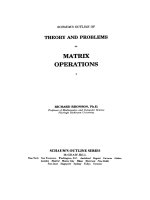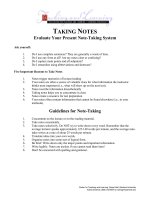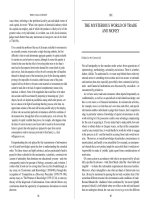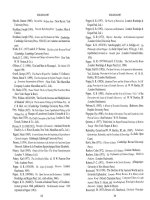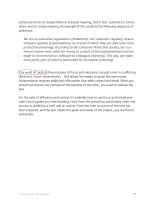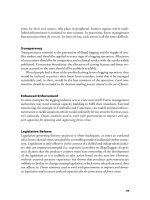schaum s easy outline of principles of economics based on schaum s outline of theory and problems of principl phần 6 ppsx
Bạn đang xem bản rút gọn của tài liệu. Xem và tải ngay bản đầy đủ của tài liệu tại đây (250.35 KB, 15 trang )
70 PRINCIPLES OF ECONOMICS
are numerous reasons why the private sector holds money balances.
These reasons can be categorized into types of demand, as follows: (1) a
transaction demand, since money is needed to purchase goods and ser-
vices, to pay employees, etc.; (2) a precautionary demand, since money
may be held to meet emergency and unforeseen needs that may arise; (3)
a portfolio (asset) demand, since some money balances are held in the ex-
pectation of opportunities in the financial markets. When there is a fixed
demand for money, an increase in the M1 money supply lowers the short-
term nominal rate of interest, ceteris paribus.
Example 7.2
LЈ in Figure 7-1 depicts the demand for money. The amount of money de-
manded is inversely related to the rate of interest since the holder of mon-
ey forgoes a higher interest return from an alternative financial asset.
When the Fed purchases government securities in the open market, bank
reserves increase as does the M1 money supply. Thus, money supply
curve SЈ in Figure 7-1 shifts rightward to SЉ as the M1 money supply in-
creases and the short-term rate of interest falls from i
0
to i
1
.
Figure 7-1
CHAPTER 7: The Federal Reserve and Monetary Policy 71
The downward pressure on short-term interest rates due to an in-
crease in the money supply is also evident when we consider the effect
that an increase in bank reserves has upon bank lending. In purchasing
government securities and supplying more reserves to the banking sys-
tem, the Fed increases the supply of excess reserves. Banks can encour-
age more borrowers to apply for bank loans by lowering their lending
rates. Consumer spending on large-ticketed items such as houses and cars
is interest-sensitive since individuals are likely to take out loans to pay
for major purchases. Business investment—purchases of new buildings
and equipment—is also interest sensitive. Thus, as depicted below, a Fed
increase in the money supply should lower the rate of interest, increase
interest-sensitive spending, and result in a higher level of spending and
gross domestic output.
↑ M →↓i →↑total spending →↑gross domestic product
True or False Questions
1. A savings deposit is a medium of exchange.
2. A marketable financial instrument can be traded on a secondary
market.
3. The banking system’s ability to issue check-writing deposits is
limited by the reserve requirement on checking deposits and the amount
of reserves held by the bank.
4. The maximum increase in check-writing deposits is $100,000, ce-
teris paribus, when the Fed purchases government securities valued at
$10,000 and the reserve requirement is 10 percent.
5. When there is a stable demand-for-money curve, a decrease in the
M1 money supply lowers the short-term nominal rate of interest.
6. Bank reserves increase and the fed funds rate decreases when the
Fed purchases government securities, ceteris paribus.
Answers: 1. False; 2. True; 3. True; 4. True; 5. False; 6. True
Solved Problems
Solved Problem 7.1.
a. Why are check-writing deposits included in the definition of mon-
ey?
72 PRINCIPLES OF ECONOMICS
b. Is there backing for coins, paper currency, and check-writing de-
posits?
c. How can money have value without commodity backing?
Solution:
a. In most cases, one can pay for the purchase of a good or service
with cash or by writing a check. Since checks are accepted as payment,
they are classified as money along with coins and paper currency.
b. In the U.S., coins, paper currency, and checking accounts have no
intrinsic value. While coins have a metallic content, the market value of
the coined material is considerably less than the face (monetary) value of
the coin. Paper currency is issued by the Fed and has no commodity back-
ing, while check-writing deposits are noncollateralized liabilities of de-
posit institutions.
c. Anything has value when its supply is limited and demand is vir-
tually unlimited. The basis for value for an inconvertible paper standard
(coins, paper currency, and checking accounts) is that government can
and is willing to limit its supply, economic units are willing to receive it
in payment for services, and spending units can use it to obtain goods and
services.
Solved Problem 7.2 Why are financial intermediaries essential to the ef-
ficient operation of the economy?
Solution: An economic system is judged efficient when it achieves max-
imum use of economic resources and maximum satisfaction of consumer
wants. Financial instruments and institutions generate efficiency in the
following ways:
a. The financial system increases consumer satisfaction by facilitat-
ing the allocation of spending over time. It allows some units to spend
more than their current income (dissave) and allows other spending units
to increase their future spending level by earning interest on the money
they have saved.
b. The creation of safe and liquid financial claims by financial inter-
mediaries reduces the likelihood that some savers will hold money bal-
ances idle. By rechanneling savings into the circular flow, spending flows
are stabilized. This in turn stabilizes employment and economic activity.
c. Financial instruments encourage savers to lend their savings to
those who want to spend more than their current money inflow. A large
CHAPTER 7: The Federal Reserve and Monetary Policy 73
portion of the funds borrowed from savers is used by business firms to
add to the economy’s capital stock. This increases productive capacity.
d. Since the profit motive guides the operation of financial institu-
tions, money saving is distributed to those capital uses that have the great-
est productivity.
Solved Problem 7.3 Suppose the banking system holds no excess re-
serves.
a. What is the maximum amount of check-writing deposits issued by
the banking system when reserves total $1,000 and the reserve require-
ment is (1) 0.20, (2) 0.16, and (3) 0.10?
b. Find the maximum amount of check-writing deposits when the re-
serve requirement is 0.20 and reserves total (1) $1,000, (2) $1,250, and
(3) $2,000.
c. Compare the quantity of check-writing deposits when reserves are
held constant and the reserve requirement is lowered in (a) with the quan-
tity of deposits when the amount of reserves held by banks is increased
and the reserve requirement remains constant in b.
Solution:
a. The maximum amount of check-writing deposits is found by solv-
ing D
max
= R/r. (1) D
max
is $5,000 (D
max
= $1,000/0.20); (2) $6,250; and
(3) $10,000.
b. When the reserve requirement remains at 0.20 and bank reserves
increase from $1,000 to $1,250 to $2,000, check-writing deposits in-
crease from (1) $5,000 to (2) $6,250 to (3) $10,000.
c. The situations in a. and b. show that the Fed has two alternative
ways of bringing about similar increases in the amount of check-writing
deposits; by lowering the reserve requirement or by increasing the
amount of reserves held by the banking system.
Chapter 8
Monetary and
Fiscal Policy
In This Chapter:
✔ Using Monetary and Fiscal Policy
✔ Problems with Fiscal and Monetary
Policy
✔ Price Level Changes
✔ Choosing Fiscal or Monetary Policy
✔ True or False Questions
✔ Solved Problems
Using Monetary and Fiscal Policy
Previous chapters have shown that monetary and fiscal policies are alter-
native ways of changing aggregate spending to close GDP gaps. For ex-
ample, if output is below its full-employment level, an increase in the
money supply, an increase in government spending, or a decrease in tax-
es raises aggregate spending and increases equilibrium output.
Example 8.1
Suppose the expenditure multiplier k
e
is 5, the tax multiplier k
t
is −4, and
full-employment output exists at $900. If equilibrium output is $800,
shifting the aggregate spending line upward can close the $100 recession-
74
Copyright 2003 by The McGraw-Hill Companies, Inc. Click Here for Terms of Use.
ary gap and bring the economy to full-employment
output. This could be accomplished by a $20 increase
in government spending [∆Y = k
e
∆G; $100 = 5($20)],
a $25 decrease in lump-sum taxes, or an increase in
the money supply which lowers interest rates and in-
creases investment spending $20.
Problems with Fiscal and Monetary Policy
An expansionary fiscal policy might not result in an increase in output
exactly equal to k
e
∆G because of the crowding-out effect. Government
spending increases, which raise the level of output, will usually push the
rate of interest higher. Private-sector interest-sensitive spending will
thereby fall and be crowded out by the fiscal action. Thus, the net increase
in equilibrium output due to increased government spending is usually
less than k
e
∆G. How much less depends upon the interest sensitivity of
the demand for money and the interest sensitivity of investment spend-
ing.
Example 8.2
Suppose k
e
is 5, full-employment output exists when output is $900, and
equilibrium output is initially $800. A$20 increase in government spend-
ing, ceteris paribus, should increase spending $100 and bring output to
its full-employment level. But suppose the rate of interest increases as a
result of the $20 increase in government spending and investment spend-
ing declines $5. The net effect of the government’s fiscal action is then
$75 rather than $100, and full-employment output is not reached. The net
effect equals ∆G(k
e
) +∆I(k
e
) = $20(5) − $5(5) = $75. Since policymak-
ers do not know in advance the extent to which there will be crowding
out, the effect of a stimulative fiscal policy upon output is uncertain.
You Need to Know
Crowding out may partially negate fiscal policies
and so must be considered carefully when imple-
menting any action.
CHAPTER 8: Monetary and Fiscal Policy 75
Normally, the rate of interest falls and interest-sensitive spending
and equilibrium output increase when the Fed increases the money sup-
ply. While most economists agree that changes in the money supply im-
pact interest-sensitive spending, there is substantial disagreement about
the predictability of the effect. Keynesians have traditionally argued that
there is considerable uncertainty about the effect a money supply change
has upon the rate of interest and the level of investment. Monetarists con-
tend that a change in the money supply has a highly predictable effect
upon nominal GDP. The disagreement about the predictability of a mon-
ey supply change has centered around the velocity of money (average cir-
culation of a unit of money in the economy) and its variability. When the
demand for money and/or the investment demand are subject to unpre-
dictable shifts, the effect of a money supply change upon equilibrium out-
put is uncertain.
Price Level Changes
In an aggregate demand and aggregate supply
framework, an economic stimulus is constrained by
a possible increase in the price level. (Note: previ-
ous chapters assumed there would be no increase in
the price level until the economy reached its full-
employment level of output. Such a scenario is un-
likely to exist in the real world.) It therefore follows
that the effect on output of a monetary or fiscal stim-
ulus depends upon the slope of the aggregate supply curve. A steeply
sloped aggregate supply curve has a smaller effect upon output than a rel-
atively flat one. While the actual steepness of the aggregate supply curve
is unknown, it is generally believed that aggregate supply is more steeply
sloped the closer output is to its full-employment level.
Important!
Price level changes constrain any monetary or fis-
cal policy, but are difficult to counteract because
the slopes of the aggregate demand and aggre-
gate supply curves can only be estimated.
76
PRINCIPLES OF ECONOMICS
Example 8.3
Suppose k
e
is 5, there is no crowding out, and full-employment output is
$600. Equilibrium output is initially $500 in Figure 8-1 for aggregate de-
mand and aggregate supply curves AD
1
and AS
1
. The recessionary gap
is $100 since full-employment output is $600; the price level is initially
p
0
. Since the expenditure multiplier is 5, a $20 increase in government
spending should increase output $100 and bring output to its full-em-
ployment level when the price level remains at p
0
. This $100 increase in
spending is presented in Figure 8-1 by the shift of aggregate demand from
AD
1
to AD
2
. Since aggregate supply AS
1
is positively sloped, the price
level rises from p
0
to p
1
. This increase in the price level decreases pri-
vate-sector spending; equilibrium output thus increases to $580 rather
than to $600. Suppose the aggregate supply curve is AS
2
rather than AS
1
.
Figure 8-1 shows that the increase in aggregate demand from AD
1
to AD
2
raises the price level to p
2
rather than p
1
, and equilibrium output is $540.
CHAPTER 8: Monetary and Fiscal Policy
77
Figure 8-1
Note that there is a smaller increase in equilibrium output but a larger in-
crease in the price level because aggregate supply curve AS
2
is more
steeply sloped than AS
1
.
Choosing Fiscal or Monetary Policy
Other factors also influence the choice of a monetary or fiscal stimulus:
how quickly the economic stimulus impacts economic activity and how
the economic stimulus affects the economy’s struc-
ture of output. Achange in government spending nor-
mally has the most immediate impact on economic
activity since a change immediately affects spending
levels. The response to money supply changes is
more likely to lag. While money supply changes immediately impact the
rate of interest, the response of interest-sensitive spending to an interest
rate change may not be as immediate since many investment projects are
not ready to be started when funding costs decrease. A money supply
change, however, has a short action lag since the Fed, unlike Congress,
can respond quickly to changing economic conditions. Thus, in spite of
its longer impact lag, monetary policy is the principal economic stabi-
lization measure used in the US because of its short action lag.
Those who advocate minimal interference with the market prefer
monetary policy to fiscal policy. Monetary policy, through its interest rate
effect, works through the financial markets and impacts private-sector
spending; a fiscal action may redistribute income within the private sec-
tor or expand public rather than private-sector goods and services. For ex-
ample, a change in the personal income tax rate does not equally impact
each income class.
Note!
Monetary policy is the primary type of policy used
to affect the U.S. economy.
True or False Questions
1. An increase in government spending always crowds out an equal
amount of private-sector interest-sensitive spending.
78 PRINCIPLES OF ECONOMICS
2. The net increase in equilibrium output is $10 when k
e
is 5, gov-
ernment spending increases $10, and higher interest rates crowd out $8
of investment spending.
3. An increase in aggregate demand has no effect upon real output
when aggregate supply is vertical.
4. A $10 increase in the money supply increases equilbrium output
$50 when k
e
is 5, there is no crowding out, and aggregate supply is pos-
itively sloped.
5. Monetary policy is more frequently used than fiscal policy since
it more quickly impacts aggregate spending.
Answers: 1. False; 2. True; 3. True; 4. False; 5. False
Solved Problems
Solved Problem 8.1 What happens to equilibrium output and the price
level in Figure 8-2 when an increase in the money supply shifts aggre-
gate demand from AD
1
to AD
2
?
CHAPTER 8: Monetary and Fiscal Policy 79
Figure 8-2
Solution: The rightward shift of aggregate demand, caused by an in-
crease in the money supply, has no effect upon equilibrium output but in-
creases the price level from p
2
to p
1
. Aggregate demand shifts have no ef-
fect upon output whenever the aggregate supply curve is vertical; demand
shifts in such an economic situation only affect the price level.
Solved Problem 8.2
a. A stimulative monetary or fiscal action should increase aggregate
demand. What factors may limit the actual increase in aggregate demand?
b. An increase in aggregate demand should raise equilibrium output.
What is responsible for the size of the increase in equilibrium output?
Solution:
a. Factors that constrain the aggregate demand shift when there is a
fiscal or monetary stimulus are crowding out and the interest sensitivity
of the demand for money and investment spending. An increase in gov-
ernment spending and/or a decrease in taxes raises output, usually re-
sulting in an increase in the rate of interest. Higher interest rates can
crowd out private-sector interest-sensitive investment spending. So, the
actual increase in aggregate demand due to a fiscal stimulus depends upon
the magnitude of the crowding-out effect. An increase in money supply
raises private-sector spending by lowering the rate of interest. The actu-
al decrease in the interest rate depends upon the interest sensitivity of the
demand for money. The effect that a decrease in the interest rate has upon
spending in turn depends upon the interest sensitivity of investment
spending. Thus, a money supply increase can cause a large or small shift
of the aggregate demand.
b. An increase in aggregate demand should raise equilibrium output;
the actual increase in output depends upon the slope of the aggregate sup-
ply curve. When aggregate supply is steeply sloped, demand increases
have a smaller effect upon output than when aggregate supply is less
steeply sloped.
80 PRINCIPLES OF ECONOMICS
81
Chapter 9
Economic
Growth and
Productivity
In This Chapter:
✔ Concept of Economic Growth
✔ Growth through Population and
Capital Accumulation
✔ Supply-Side Economics
✔ True or False Questions
✔ Solved Problems
Concept of Economic Growth
Economic growth is concerned with the expansion of an economy’s abil-
ity to produce (potential GDP) over time. Expansion of potential output
occurs when there is an increase in natural re-
sources, human resources, or capital, or when there
is a technological advance. The two most common
measures of economic growth are an increase in
real GDP and an increase in output per capita. Of
these two measures, an increase in output per capi-
ta is more meaningful since it indicates there are
more goods and services available per person and
hence a rise in the economy’s standard of living. An increase in potential
Copyright 2003 by The McGraw-Hill Companies, Inc. Click Here for Terms of Use.
output can be conceptualized by an outward shift of an economy’s pro-
duction-possibility frontier. In our discussion of economic growth, we as-
sume that increases in potential output are matched by equal increases in
aggregate spending so that full-employment growth is assured.
Growth through Population and Capital
Accumulation
An increase in the labor supply, ceteris paribus, expands potential out-
put. The law of diminishing returns shows that the incremental output
from an additional labor input decreases when other economic resources
and technology are unchanged. Thus, the possibility exists that aggregate
output could increase while output per capita decreases. Expecting rapid
population growth, economists in the early nineteenth century predicted
such growth would result in declining output per capita. Thomas Malthus,
in particular, held that the population would increase at such a rapid rate
that the economy would increasingly be unable to grow enough food to
feed its population; eventually output per capita would fall to a subsis-
tence level. While technology has allowed highly industrialized countries
to avoid these gloomy projections, rapid population growth is a problem
for many developing countries.
Note!
Such theories as that of Thomas Malthus have
helped to label economics as the dismal science.
The neoclassical model of economic growth maintains that, in the
absence of technological change, an economy reaches a steady state—
where there are no further increases in output per capita. In the steady
state, capital deepening ceases, although capital widening can occur be-
cause of growth in the labor supply. Capital widening exists when capi-
tal is added to keep the ratio of capital per worker constant due to in-
creases in the supply of labor. Capital deepening occurs when there is an
increase in the ratio of capital to labor.
With no technological advance, capital additions that are capital
82 PRINCIPLES OF ECONOMICS
widening do not change output per worker; however, capital additions
that are capital deepening increase output per worker. When there is no
change in the labor force, capital additions result in
diminishing returns and have decreased rates of re-
turn. Capital additions cease—and the economy
reaches a steady state—when the rate of return from
capital additions equals the economy’s real rate of
interest. Since there is a limit to capital deepening when there is no
change in technology, there must also be a limit to output per worker and
therefore to the economy’s standard of living. An economy’s steady-state
position can be pushed to a higher level of output per worker by an in-
crease in its rate of saving, by improved technology, and/or by better ed-
ucation of its population.
Productivity is measured by dividing real GDP by the total number
of hours worked by labor. Over time, the growth of labor productivity in
the U.S. has slowed. Economists have been unable to empirically estab-
lish the cause of this productivity growth slowdown, but some potential
factors may be: (1) an increase in environmental regulations; (2) high en-
ergy costs, resulting in the substitution of more labor and capital for en-
ergy; and (3) an increase in the number of less skilled workers in the la-
bor force.
A productivity growth slowdown has implications for a country’s
standard of living. Standard of living is measured by an economy’s real
GDP per capita (total output divided by population), whereas productiv-
ity is measured as real GDP per hour of labor input (output divided by the
number of hours worked to produce this output). Suppose an economy’s
labor force is always 50 percent of its population. Increases in labor’s out-
put per hour will result in higher GDP per capita and therefore raise the
economy’s standard of living. When output per hour is unchanged, there
will be no increase in output per capita and therefore no improvement in
the economy’s standard of living.
Important!
Increased productivity has been the major source
of growth for many countries during certain peri-
ods, including the U.S.
CHAPTER 9: Economic Growth and Productivity 83
84 PRINCIPLES OF ECONOMICS
Supply-Side Economics
Concern about the slowdown in U.S. productivity growth during the
1970s helped popularize the theory of supply-side economics. Supply-
siders stressed that U.S. productivity would be enhanced by actions that
promoted incentives to produce. A decrease in private-sector taxes was
proposed. Proponents of this theory called for a decrease in corporate in-
come tax rates, which would increase corporate profits and therefore busi-
ness saving. This in turn would encourage business investment and cap-
ital accumulation. A reduction in the personal income tax rate would
increase the reward from working, which might increase labor produc-
tivity. Decreased tax rates on interest income and corporate dividends
would increase household saving, which would result in capital deepen-
ing. While not identified as supply-side economics, various measures
were promoted in the 1990s that would also increase the economy’s abil-
ity to produce. Improvement of the U.S. educational system would en-
hance labor skills, increase labor productivity, and thereby promote eco-
nomic growth.
You Need to Know
Supply-siders can come from any political party,
but different groups tend to favor specific policies
(i.e., tax cuts or increased education).
Example 9.1
In Figure 9-1, assume that the labor supply and population are unchanged
and that a combination of tax incentives and a better-educated population
shift the aggregate supply curve AS
1
to AS
2
. An increase in the money
supply shifts aggregate demand from AD
1
to AD
2
; the price level remains
constant and output increases from y
1
to y
2
. Since there is no change in
population, output per capita has increased with an attending rise in the
economy’s standard of living.


